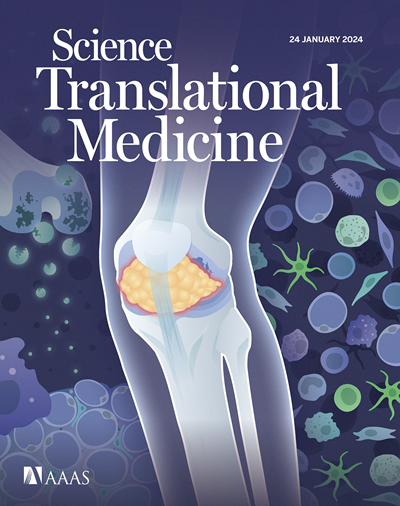A microfluidic wearable device for wound exudate management and analysis in human chronic wounds
IF 15.8
1区 医学
Q1 CELL BIOLOGY
引用次数: 0
Abstract
Chronic wounds are a major global health challenge associated with substantial economic burden and a negative impact on patient quality of life. Real-time analysis of biomarkers like reactive oxygen and nitrogen species could guide treatment, but existing systems lack the capacity required for continuous monitoring. Wound exudate is secreted slowly and has a complex composition, making efficient fluid collection and real-time analysis challenging. To address these issues, we introduce iCares, a wearable device for wound exudate management and continuous in situ analysis of wound biomarkers. iCares contains a flexible nanoengineered sensor array that measures reactive species such as NO, H2O2, and O2, along with pH and temperature, providing multiparameter data to inform wound status. The device features pump-free triad microfluidic modules with a superhydrophobic-superhydrophilic Janus membrane, bioinspired wedge channels, and three-dimensional graded micropillars for efficient unidirectional exudate collection, transport, and refreshing. The sensors demonstrated a consistent response and analyte selectivity in vitro and in wound exudate. iCares was designed for rapid scalable manufacturing through advanced printing and laser patterning. Wireless connectivity supported long-term continuous monitoring in wounds. The iCares system real-time monitoring was tested in a murine model of diabetic skin wound during infection and antimicrobial treatment. Clinical wound evaluation was conducted in 20 patients with chronic wounds and in two patients before and after surgery. A machine learning analysis of the multiplexed data successfully classified wounds and healing times, indicating that wound exudate analysis by iCares could offer insight into chronic wound status to aid in treatment decisions.
一种用于人体慢性伤口渗出液管理和分析的微流控可穿戴设备
慢性伤口是一项重大的全球健康挑战,与沉重的经济负担和对患者生活质量的负面影响有关。对活性氧和氮等生物标志物的实时分析可以指导治疗,但现有系统缺乏持续监测所需的能力。伤口渗出液分泌缓慢,成分复杂,使有效的液体收集和实时分析具有挑战性。为了解决这些问题,我们介绍了iCares,一种可穿戴设备,用于伤口渗出液管理和伤口生物标志物的连续原位分析。iCares包含一个灵活的纳米工程传感器阵列,可以测量NO、H2O2和O2等反应性物质,以及pH和温度,提供多参数数据来了解伤口状态。该设备具有无泵的三元微流控模块,具有超疏-超亲水Janus膜、仿生楔形通道和三维梯度微柱,可有效地单向收集、运输和刷新渗出液。该传感器在体外和伤口渗出液中表现出一致的反应和分析物选择性。iCares通过先进的印刷和激光图案设计用于快速扩展制造。无线连接支持伤口的长期连续监测。应用iCares系统实时监测糖尿病皮肤创面感染和抗菌治疗过程。对20例慢性创面患者和2例手术前后患者进行临床创面评估。对多路数据的机器学习分析成功地对伤口和愈合时间进行了分类,表明iCares的伤口渗出物分析可以提供对慢性伤口状态的洞察,以帮助治疗决策。
本文章由计算机程序翻译,如有差异,请以英文原文为准。
求助全文
约1分钟内获得全文
求助全文
来源期刊

Science Translational Medicine
CELL BIOLOGY-MEDICINE, RESEARCH & EXPERIMENTAL
CiteScore
26.70
自引率
1.20%
发文量
309
审稿时长
1.7 months
期刊介绍:
Science Translational Medicine is an online journal that focuses on publishing research at the intersection of science, engineering, and medicine. The goal of the journal is to promote human health by providing a platform for researchers from various disciplines to communicate their latest advancements in biomedical, translational, and clinical research.
The journal aims to address the slow translation of scientific knowledge into effective treatments and health measures. It publishes articles that fill the knowledge gaps between preclinical research and medical applications, with a focus on accelerating the translation of knowledge into new ways of preventing, diagnosing, and treating human diseases.
The scope of Science Translational Medicine includes various areas such as cardiovascular disease, immunology/vaccines, metabolism/diabetes/obesity, neuroscience/neurology/psychiatry, cancer, infectious diseases, policy, behavior, bioengineering, chemical genomics/drug discovery, imaging, applied physical sciences, medical nanotechnology, drug delivery, biomarkers, gene therapy/regenerative medicine, toxicology and pharmacokinetics, data mining, cell culture, animal and human studies, medical informatics, and other interdisciplinary approaches to medicine.
The target audience of the journal includes researchers and management in academia, government, and the biotechnology and pharmaceutical industries. It is also relevant to physician scientists, regulators, policy makers, investors, business developers, and funding agencies.
 求助内容:
求助内容: 应助结果提醒方式:
应助结果提醒方式:


